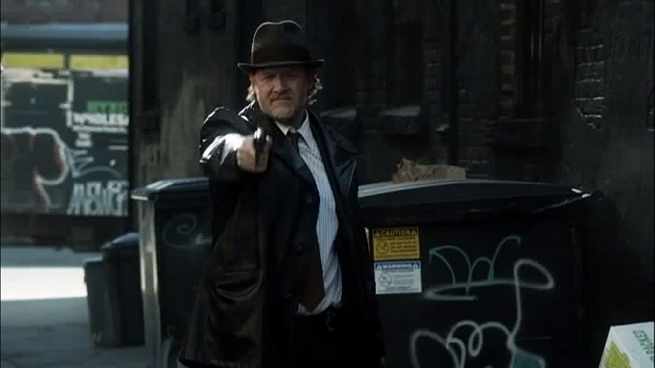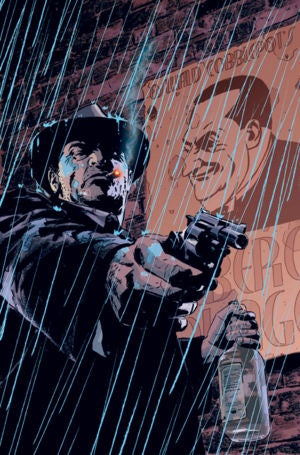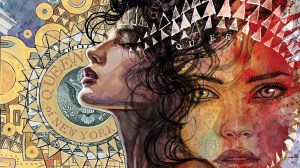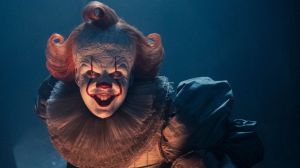
Videos by ComicBook.com
The series, from Warner Bros. Television and DC Entertainment, takes fans into the past of Gotham City, set before Bruce Wayne became Batman and the city was overrun by costumed lunatics. Here, instead, it’s just a bleak and corrupt world full of brutal cops and colorful, powerful criminals.
Our “Easter Eggs” posts always walk a fine line between servicing an individual episode and the series at large; as the season goes on and characters and concepts recur, it becomes harder to determine which things are still worth calling attention to versus which are just part of making the show work. For this first episode, I just decided that I won’t point out Jim Gordon and Harvey Bullock, the series’ two principal leads, but that just about everybody else would get a quick mention. In the future, we won’t bother to do that, but this is setting a baseline. We don’t really know yet who will be regular, recurring or just a one-off guest.
Edit: And, yes, we know Eddie Nygma (The Riddler) was in the episode, getting an overt name drop and acting all Riddler-y. You can stop commenting about it. The really didactic nature of the “OMG, look, it’s [insert name here]” in the pilot had me debating up until the last minute whether it was worth the trouble to even point those characters out since they were so painfully obvious, but at one point along the way I decided to do so since if I didn’t, readers would revolt in the comments. Unfortunately by then, I’d forgotten all about Nygma. That’s the risk of doing these things live…
Catwoman
Selina Kyle, who will be the focus of the series’ second episode next week, makes her first appearance here, and is in fact weirdly the first person we see onscreen.
Gargoyles
She’s joined onscreen by gargoyles, one of Batman’s longtime best friends!
No matter where he is in Gotham City, Batman seems to have gargoyles to pose on and around. In film adaptations, they tend to be played a bit down, but this rather over-the-top approach to Gotham City is a place where they’ll fit in pretty well.
Bruce Wayne and the Wayne murder
We get a retelling of the Wayne murder — something that it’s almost a running joke at this point that nobody needs to see again. What makes this time a bit different, of course, is that it isn’t Bruce’s angst and fury that drives the story but rather the police investigation.
Ironically, director Danny Cannon responded to that by showing Bruce’s pain and rage more clearly in the moments following his parents’ death than ever before (presumably becuase later we won’t be dwelling on it).
The Wayne murder is an interesting case: we get a look at the killer’s eyes and have a general sense for his shape, but obscuring his face suggests that the mystery they’re building this year might, y’know, lead somewhere. If it was just an anonymous killer who was never to be caught, there would be no need to keep the audience in suspense…except, of course, that the audience will want to see Gordon succeed.
This is further complicated by the fact that, depending on the story, sometimes the Wayne murder does go unsolved.
Don’t be too surprised, especially if the series is the runaway success it’s expected to be, if they draw out the investigation for a second year. There are elements of the murder mystery that feel very inspires by The Killing, which famously did that (to disastrous ratings effect, but they didn’t have Gotham‘s built-in base, either).
The cape
Yes, we can’t help but notice that when Bruce is entirely wrapped up in the blanket at the crime scene it’s vaguely reminiscent of a cape.
This version of Alfred
As has been noted, this version of Alfred Pennyworth seems fairly inspired by the Batman: Earth One version, who is a bit more gruff and rough, having been a former Royal Marine.
The dynamic between he and Bruce is certainly a bit unconventional, though, and not nearly as warm as we’re used to in, say, the Christopher Nolan films. There’s a beat here where Alfred voices an objection and Master Bruce just has his say and…that’s it. It’s a bit jarring, and certainly tells us about the starting points for this version of the characters.
“Be strong”
We get the “be strong” speech here, suggesting that perhaps Gordon can be somewhat credited in the creation of Batman. That would seem like a stretch if not for the fact that so much of the show seems to be dedicated to the “Before Batman…” narrative.
Montoya and Allen
While they don’t get much screen time in the pilot and are depicted as antagonists more than anything else, Renee Montoya and Crispus Allen from Gotham Central appear as the MCU detectives who are investigating Bullock and Gordon’s connections to the mob.
Captain Essen
Gordon’s second wife in the comics is his supervisor here.
Penguin and his umbrella
Yes, yes. They called him Penguin.
He’s also got that umbrella, which is effectively a symbol of his servitude to Fish Mooney here, but which we know will become inextricably connected to his character. Will we see the umbrella-gun by the end of the season? Certainly it would have been easier to explain if he hadn’t had an immediate break with Fish. Were he still wielding the umbrella in her service all season long, eventually rigging it as a potential weapon to use against her would have been an obvious story choice. Here…well, we’ll have to see.

Barbara Kean, here the fiancee of Jim Gordon and in the comics, the mother of James, Jr. and Barbara Gordon, apparently lives in an apartment which, instead of a window, has a clock face that looks out on Gotham.
why’s that so significant? Well, during her daughter’s time as Oracle, providing intel to the supehrero community, the headquarters for Oracle and her Birds of Prey operation was…you guessed it…inside a clocktower in Gotham City.
The Gotham Clocktower was featured in Birds of Prey, a short-lived show on The CW, as well as on Arrow (it was destroyed…maybe so as not to draw unwanted parallels to this one when Gotham aired?). Of course, Barbara Gordon never appeared on Arrow, where the Birds of Prey haven’t really officially formed yet but it’s widely expected that Felicity Smoak will one day fulfill the Oracle role.
Falcone
Fish Mooney and the other gangsters in this episode work for Carmine Falcone — a criminal we do see briefly toward the end of the pilot. He’s a fixture in the Gotham organized crime community in the comics and is referenced in Batman Begins, where he’s responsible for killing Joe Chill, the man who murdered the Waynes.
Gotham’s born on a Monday
“Meet me at Fourth and Grundy in an hour,” says Harvey Bullock to Gordon on the phone. Solomon Grundy is a classic DC Comics villain with ties to Batman and Green Lantern, among others. His civilian identity has already appeared on Arrow.

At first, I thought this said “The Gotham City Gas Co.,” which is where some scenes from Batman V Superman: Dawn of Justice have been set. Once I grabbed it off my screen and reversed it for clarity, though? It looks like “Gotham City Casino.”
In the Flashpoint Universe, it was the Waynes who owned a casino in Gotham City. In the “regular” DC Comics Universe? Well, The Penguin (who you might have noticed in this episode) owns the Iceberg Casino.
Could this be a very, VERY subtle teaser of things to come?
Poison Ivy
Ivy Pepper is apparently Poison Ivy in this world, not Pamela Eisley. So we’ve seen how she lost her dad and that she doesn’t particularly like the police — not without good reason.

Immediately after killing Mario Pepper, Bullock is standing in the alley with his gun arm extended in what’s apparently an homage to a classic cover featuring the character. This image is so famous that when Bullock was announced as part of the cast, it was the image used by nearly every news outlet covering the story.

The question of whether Harvey Bullock is really a dirty cop or not is something that has often hung over the character; at one point he even had to leave the force amid controversy. Generally, though, he comes through in the end…!
Crane/Scarecrow
In the cemetery when Bullock and Gordon see Bruce, there is a tombstone shown briefly onscreen that appears to say “William Crane.” One assumes he would be related to Jonathan Crane, the Scarecrow.
[EDIT: One commenter below says that it appears to say “Wilhelm Craig.” Certainly possible. I’m going by naked eye.]
Selina’s fascination with Bruce
In basically every version of the mythos, Selina Kyle has an obsession or fascination with Bruce and/or the Batman that’s sometimes hard to explain. Here, we get a dual explanation: they’re polar opposites, as she’s a street urchin and he’s a billionaire…but also, she saw the murder and is apparently really compelled to find out what happens next with this boy whose life she saw change for the worse right in front of her.
Montoya’s sexuality/drug problem
This episode, we get the revelation that not only has Renee Montoya had a relationship with Barbara Kean at some point in the past, but also that she’s a “pillhead looney,” suggesting that she’s got known and documented substance abuse problems.
We’ve seen both of those facets of Renee’s character in the comics before, and each of them has set in motion a certain amount of story. It’ll be interesting to see how they play either or both in this show.
Nightclub comedian
We saw The Joker as an unfunny, struggling and anonymous nightclub comedian in The Killing Joke — and this is just the first of what showrunners have promised are a number of teases as to the identity of the Joker in the series. Don’t get too attached to this idea, then, but hey! There it is, right in the pilot.
What did Falcone say?
To me, it sounded like he said, “in bocca al lupo,” which translates loosely as the colloquialism “Break a leg.” Marlene From I Like Comics Too on Twitter suggested that she thought she had heard a phrase that (translating to Italian via Spanish) means “the closed mouth.”
Hers probably makes more sense, but I still think that’s what I heard.
Bruce v fear
Creating a relationship between Bruce Wayne and the fear that makes his enemies a superstitious, cowardly lot is pretty fun.
Creating a relationship between Bruce and Gordon, dependent on suspension of the law for the greater good? Even better.
Bonus Round: The Easter Eggs That Weren’t!
In the promotional run-up to the series, there were quite a few things that we saw, ostensibly from the pilot that didn’t make it into the final cut. One is the newspaper that described Gordon as a war hero returning to join the police (it never seemed particularly likely to make it in, given that it was a banner headline in a major metropolitan newspaper dedicated to a “local man done good” story).
The other, and probably the one far more people were watching out for, was the blood pattern on the sheet that covered Thomas and Martha Wayne, which during the promotional campaign at one point was stained in a pattern reminiscent of Heath Ledger’s Joker makeup. The blood stains on the actual sheet that covered the bodies may have looked that way, but we never got a “glamor shot” of it in the pilot as we did in the ad so it’s impossible to know.








